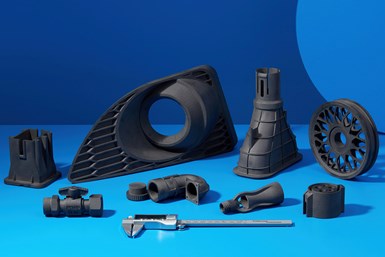Formlabs’ Nylon 12 GF SLS Powder for Stiffness, Thermal Stability
The company says this glass-filled nylon 12 material is well suited for manufacturing and engineering parts in which structural rigidity and thermal stability are critical.

It is said the Nylon 12 GF Powder offers users the ability to design, customize and produce parts that can withstand sustained load and elevated temperatures. Photo Credit: Formlabs
Formlabs’ Nylon 12 GF Powder is the latest addition to its selective laser sintering (SLS) materials library. The company says this high-performance, nylon-based, glass-filled material is well suited for producing stiff functional prototypes and end-use parts production where structural rigidity and thermal stability are critical.
The material is available for use on the Fuse 1, Formlabs’ SLS 3D printer. It is said the material enables users to print thermally stable parts that can maintain dimensional accuracy under load. The company says the release of Nylon 12 GF Powder is one of many materials it plans to launch for its Fuse 1 as it endeavors to offer a complete solution for end-use 3D printing by expanding the versatility of its powder-based materials.
The Fuse 1 ecosystem is said to make industrial 3D printing more cost accessible and user-friendly with its straightforward process. It is said that materials are key to expanding the range of possible applications, and this glass-filled nylon 12 was developed as a solution for environments that require highly stable and functional parts that have to maintain dimensional accuracy under load, even at elevated temperatures.
Nylon 12 GF Powder is the third material added to the company’s SLS materials library for the Fuse 1, expanding its functionality and enabling users to print highly durable, long-lasting, end-use parts in-house. According to the company, its materials, hardware and software are developed and validated together to deliver peak performance while optimizing cost per part.
This powder is said to build upon the existing capabilities of the Fuse 1 to offers manufacturers, engineers and product designers the ability to design, customize and produce parts that can withstand sustained load and elevated temperatures. It is said to add an extra element of stiffness for cases that require structural and thermal stability and is well suited for creating robust jigs, fixtures and replacement parts, parts undergoing sustained loading, functional prototypes for composite parts, threads and sockets, and parts subjected to high temperatures.
Related Content
-
Q&A With Align EVP: Why the Invisalign Manufacturer Acquired Cubicure, and the Future of Personalized Orthodontics
Align Technology produces nearly 1 million unique aligner parts per day. Its acquisition of technology supplier Cubicure in January supports demand for 3D printed tooling and direct printed orthodontic devices at mass scale.
-
Copper, New Metal Printing Processes, Upgrades Based on Software and More from Formnext 2023: AM Radio #46
Formnext 2023 showed that additive manufacturing may be maturing, but it is certainly not stagnant. In this episode, we dive into observations around technology enhancements, new processes and materials, robots, sustainability and more trends from the show.
-
6 Trends in Additive Manufacturing Technology at IMTS 2024
3D printers are getting bigger, faster and smarter. But don’t overlook the other equipment that the AM workflow requires, nor the value of finding the right supplier.













